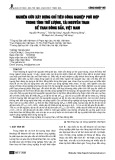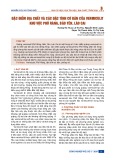
Journal of Mining and Earth Sciences, Vol 65, Issue 6 (2024) 47 - 57 47
Prediction of Poisson's ratio for hydraulic fracturing
operations in the Oligocene formations in the Bach Ho
field
Tu Van Truong 1,*, Vinh The Nguyen 1 , Long Khac Nguyen 1, Thinh Van Nguyen 1,
Hung Tien Nguyen 1, Tai Trong Nguyen 2, Thinh Duc Kieu 3
1 Hanoi University of Mining and Geology, Hanoi, Vietnam
2 Zarubezhneft E&P Vietnam, HoChiMinh City, Vietnam
3 Thuy Loi University, Hanoi, Vietnam
ARTICLE INFO
ABSTRACT
Article history:
Received 23rd June 2024
Revised 10th Oct. 2024
Accepted 04th Nov. 2024
In rock geomechanics analysis, Poisson's ratio is one of the critical factors that affect
mechanical properties of rocks and soils, wellbore stability, in situ stress, drilling
efficiency, and hydraulic fracturing design. There are two conventional methods for
measuring Poisson's ratio, they are called acoustic wave method and compression
testing of core sample. In the first, the Poisson's ratio is determined based on well-log
data known as dynamic values. Conversion formulas need to be established for
different geological conditions to obtain reliable computational results. However, the
determination of each suitable conversion formula is time and money-consuming, as
well as the process, is relatively complicated. The latter method must be performed
in the laboratory with high accuracy equipment and requires the availability of core
samples obtained through the coring process with high expenditure. To overcome the
limitations of these two methods, the authors used the Artificial Intelligence
technique to establish correlations between the value of Poisson's ratio and drilling
parameters (e.g., weight on bit, flow rate, torque, annulus velocity, pressure losses) in
the Oligocene formation of the Bach Ho field. Two machine learning algorithms
including Random Forest (RF) and Decision Tree (DT) were applied in this study. On
the other hand, the offset data from Well A and Well B penetrated through the
Oligocene formation of the Bach Ho field were used to build, train, and verify the
accuracy of the artificial intelligence simulations. Both wells have similarities in
lithological characteristics and composition. The results indicated that the Artificial
Intelligence models are highly accurate in predicting the value of Poisson's ratio, with
correlation coefficient results for the RF model and the DT model being at 0.79 and
0.76 respectively.
Copyright © 2024 Hanoi University of Mining and Geology. All rights reserved.
Keywords:
Decision tree - DT,
Hydraulic Fracturing,
Poisson’s ratio,
Random forest - RF.
_____________________
*Corresponding author.
E-mail address: truongvantu@humg.edu.vn
DOI: 10.46326/JMES.2024.65(6).05

48 Tu Van Truong et al./Journal of Mining and Earth Sciences 65 (6), 47 - 57
1. Introduction
Hydraulic fracturing is a highly effective
methodology for the improvement of the
production rate of oil and gas wells as well as
enhancing the formation capacity for injection
wells. In this method, injection fluid is pumped into
a reservoir formation at high pressure to induce
additional fractures. Subsequently, sand/propant
is pumped into the reservoir to keep the fractures
open to maintain the permeability and sustain the
conductivity after the fracturing process is
completed. In the hydraulic fracturing design
simulation for fractures, the key input data
including Young's modulus and Poisson's ratio, are
related to the mechanical properties of rock
formation (Tu et al., 2017).
For the fracture simulations, Young's module,
Poisson's ratio, and other geomechanical
parameters of formations are typically determined
by core compression tests and the interpretation
from well-log data. However, there are some
limitations to the application of these methods. The
values obtained from well log data interpetation
shall be indicated as "Dynamic", thus they are not
suitable for wellbore stability analysis. To obtain
reliable calculation in the wellbore stability
analysis, it is necessary to convert “Dynamic” to
“Static” values in the geological condition
respectively. References suggest that the Dynamic
Poisson's ratio is higher than the Static Poisson's,
and the relationship between them is not clear,
especially for low-deformative rock formations.
The differences between these values are
explained by the influence of porosity, size and
orientation of fractures. Finding an appropriate
conversion formula requires significant time, cost,
and relative complexity (Abdallah et al., 2014; Lal,
1999). Core compression tests in the laboratory
offer a high accuracy but they require available
core samples, additional equipment, and
sometimes the need for supplementary core
measurement results, which consume time and
sampling costs (Müller et al., 2019).
Researchers face the challenge of establishing
a causal relationship between Poisson's ratio and
drilling parameters. Some authors, including
Elkatatny (2021), Mutalova et al. (2020), and
Siddig et al. (2021), have applied Artificial
Intelligence (AI) to derive geomechanical
parameters such as Young's modulus, Poisson's
ratio, bulk modulus, shear modulus, and minimum
horizontal stress-from well log data or drilling
parameters. These AI-driven approaches offer a
more efficient, cost-effective, and rapid means of
predicting fracture development and enhancing
fracturing efficiency. Building on this, studies by
Abdulraheem et al. (2019) and Ahmed et al. (2021)
demonstrated the high accuracy of AI models like
artificial neural networks (ANNs) and adaptive
neuro-fuzzy inference systems (ANFIS) in
predicting Poisson’s ratio from well-log data.
Siddig et al. (2021) further explored real-time
prediction using drilling parameters and machine
learning, achieving strong correlations with
minimal error. Additionally, Müller et al. (2019)
provided an efficient laboratory method for
determining Poisson’s ratio, validated against
traditional techniques. These diverse
methodologies highlight AI's potential in
overcoming traditional limitations, particularly in
correlating Poisson's ratio with various influencing
parameters, including real-time drilling data.
Building on these advancements, this study
aims to compare the performance of two models:
Random Forest (RF) and Decision Tree (DT). By
evaluating their accuracy and efficiency in
predicting the Poisson coefficient, this study seeks
to determine which model offers superior
performance and robustness for this application.
2. Data Description and Analysis
2.1. Data Description
In this study, data was collected from drilling
operations in the Bach Ho field, offshore Vietnam.
The drilling parameters and related Poisson's ratio
values while drilling a 8 ½” hole section shall be
utilized. Meanwhile, the lithological composition of
the Oligocene formation (from upper to lower)
consists of shalestone and sandstone as given in
Figure 1. Well A contributed a total of 714 data
points used for building the study model. Among
those data points, there are 70% of the data are
used for the training set and the rest is used for
model verification. On the other hand, 196 data

Tu Van Truong et al./Journal of Mining and Earth Sciences 65 (6), 47 - 57 49
points from Well B were used for model validation.
In addition to Poisson's ratio as the output, each
data point contains drilling parameters used as
input parameters. The drilling parameters listed
below were measured in the field and used to build
a predictive model:
- Weight on bit (WOB);
- Torque on bit (TQR);
- Standpipe pressure (SPP);
- Rotary speed (RPM);
- Flow rate (FLOWIN);
- Rate of penetration (ROP).
2.2. Data Analysis
Before running the data through machine
learning algorithms, the datasets were
preprocessed to remove noise and outliers using
the Z-score method (Tripathy et al., 2013),
analyzing the data based on the correlation
between two variables. Statistical analysis of the
dataset used for model construction is presented in
Table 1.
Figure1. Lithology column for Well A.

50 Tu Van Truong et al./Journal of Mining and Earth Sciences 65 (6), 47 - 57
The selection of input data for training and
testing process is an important step that
determines the accuracy of the model. The
correlation coefficients between the Poisson's ratio
and different drilling parameters are presented in
Figure 2. From Figure 2a, it can be observed that
the correlation coefficients between the drilling
parameters and Poisson's ratio are all below 0.5.
Therefore, applying artificial intelligence models
will offer better results than linear regression
methods as they can approximate more complex
relationships.
In Figure 2b, a relatively strong correlation is
shown between the Poisson's ratio and some
drilling parameters such as standpipe pressure
(SPP), torque on bit (TQR), weight on bit (WOB),
and rate of penetration (ROP). Lower correlation
coefficients for other parameters do not
necessarily imply the absence of a relationship
between these inputs and the Poisson's ratio. It
indicates that a linear equation does not
adequately describe the relationship between the
inputs and the output. These analyses highlight the
importance of the parameters. Specifically, it is
shown that achieving 95% importance requires 6
parameters. This indicates that the selected dataset
is highly reliable and that the chosen features are
crucial for ensuring model accuracy.
3. Methodology
In prediction stage of the Poisson's ratio from
drilling parameters, the authors utilise an
algorithm flowchart as given in Figure 3. The input
data consists of drilling parameters and actual
Poisson's ratio from two wells, A and B. Data from
well A was split into a train set (70%) and a test set
(30%) for the model training process. Data from
well B was used as an independent test set to
validate the accuracy of the trained model.
Random Forest and Decision Tree Algorithms
With the aim of building the relationship
between Poisson’s Ratio and drilling parameters,
two machine learning algorithms, DT and RF, were
used separately. Both algorithms could perform
ROP
WOB
RPM
TQR
SPP
FLOWIN
POISSON
Count
714
714
714
714
714
714
714.000
Mean
17.44
8.27
117.47
1575.95
195.26
37.78
0.316
Std
9.99
1.90
20.96
204.29
24.18
9.30
0.029
Min
0.78
2.33
40.00
1037.60
143.32
22.06
0.200
25%
11.86
7.07
116.00
1534.15
184.28
34.77
0.301
50%
17.35
8.41
121.00
1593.30
202.85
38.05
0.320
75%
21.07
9.20
122.00
1669.88
212.06
38.10
0.337
Max
45.40
13.87
161.00
2185.30
224.00
54.64
0.392
Table 1. Input database.
Figure 2. The correlation between predicted coefficient and the parameters used for prediction stage.

Tu Van Truong et al./ Journal of Mining and Earth Sciences 65 (6), 47 - 57 51
classification and regression tasks, but for this
paper, only regression was employed and
discussed.
Decision Tree
The training data for DT Regression is
represented as (x, y) = (x1, x2, ..., xk, y), where: y is
the target variable (Poisson coefficient) and x1, x2,...,
xk are independent variables of drilling
parameters.
The process of building a regression DT
involves two steps (James et al., 2017):
a. Prediction space, which is the set of
values for x1, x2, ..., xk, is divided into J
distinct and non-overlapping regions, R1,
R2, ..., RJ.
b. For all of the observed variables in the
region Rj, the same prediction is made,
which is the average value of the target
variable for training observations in Rj.
To build optimal regions R1, R2, ..., RJ, the
prediction space is divided into multidimensional
boxes that minimize the residual sum of squares
(RSS):
𝑅𝑆𝑆 = ∑ ∑ (𝑦𝑖−𝑦𝑅𝑗)2
𝑖∈𝑅𝑗
𝐽𝑗=1
(1)
Where y (Rj) - is the average value of the target
variable in the jth box.
Random Forest
RF is an ensemble learning algorithm
proposed by Breiman in 2001 (Breiman, 2001). It
constructs a large number of random decision
trees on bootstrapped training samples and
aggregates their predictions by averaging the
results (James et al., 2017). It has become a major
data mining tool for both regression and
classification problems. Recently, the consistency
of RF has been proven by Scornet in 2015 (Scornet
et al., 2015). Compared to other machine learning
algorithms like neural networks, RF can achieve
relatively high prediction performance with only a
few adjustable parameters (Genuer et al., 2017).
There are several open-source
implementations of DT and RF algorithms, among
which scikit-learn (Pedregosa et al., 2011;
https://scikit-learn.org/) is a widely machine
learning library chosen for these studies, with the
parameter sets described in the next section.
Selection of Parameter Sets for RF and DT
Algorithms
The selection of parameters for both the RF
and DT algorithms is described in step 3 of the
algorithm flowchart in Figure 3. The parameters
for both algorithms are presented in Table 2 and
Table 3, respectively (https://scikit-learn.org/).
Model Performance:
To evaluate all model experiments, five
statistical metrics were employed: the correlation
coefficient (R), the average absolute percentage
error (AAPE), the mean absolute error (MAE), the
coefficient of determination (R²), and the root
mean square error (RMSE). These metrics were
calculated using the following equations:
𝑅
=[𝑁∑(𝜇𝑔𝑖𝑣𝑒𝑛 𝑖 × 𝜇𝑃𝑟𝑒𝑑𝑖𝑐𝑡𝑒𝑑 𝑖
𝑁
𝑖=1 )]−[∑(𝜇𝑔𝑖𝑣𝑒𝑛 𝑖 × 𝜇𝑃𝑟𝑒𝑑𝑖𝑐𝑡𝑒𝑑 𝑖
𝑁
𝑖=1 )]
√[𝑁∑(𝜇𝑔𝑖𝑣𝑒𝑛 𝑖)2−(∑𝜇𝑔𝑖𝑣𝑒𝑛 𝑖)
𝑁
𝑖=1 2
𝑁
𝑖=1 ][𝑁∑(𝜇𝑃𝑟𝑒𝑑𝑖𝑐𝑡𝑒𝑑 𝑖)2−(∑𝜇𝑃𝑟𝑒𝑑𝑖𝑐𝑡𝑒𝑑 𝑖)
𝑁
𝑖=1 2
𝑁
𝑖=1 ]
(2)
𝐴𝑃𝐸=∑𝜇𝑔𝑖𝑣𝑒𝑛 𝑖−𝜇𝑃𝑟𝑒𝑑𝑖𝑐𝑡𝑒𝑑 𝑖
𝜇𝑔𝑖𝑣𝑒𝑛 𝑖 ×100%
𝑁
𝑖=1 𝑁
(3)
𝑀𝐴𝐸= 1
𝑁∑|𝜇𝑔𝑖𝑣𝑒𝑛 𝑖−𝜇𝑃𝑟𝑒𝑑𝑖𝑐𝑡𝑒𝑑 𝑖|
𝑁
𝑖=1
(4)
Figure 3. Flow chart for generation of AI model.

























![Quyển ghi Xác suất và Thống kê [chuẩn nhất]](https://cdn.tailieu.vn/images/document/thumbnail/2025/20251030/anh26012006/135x160/68811762164229.jpg)
